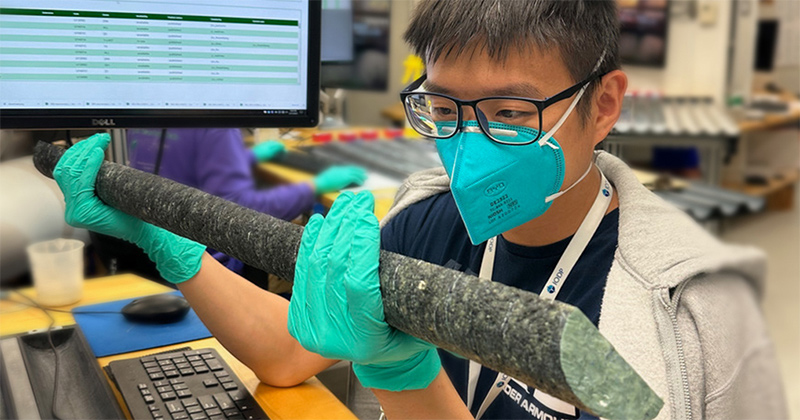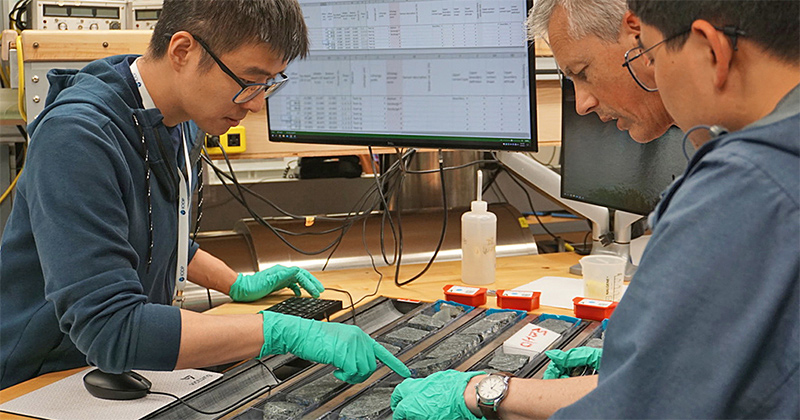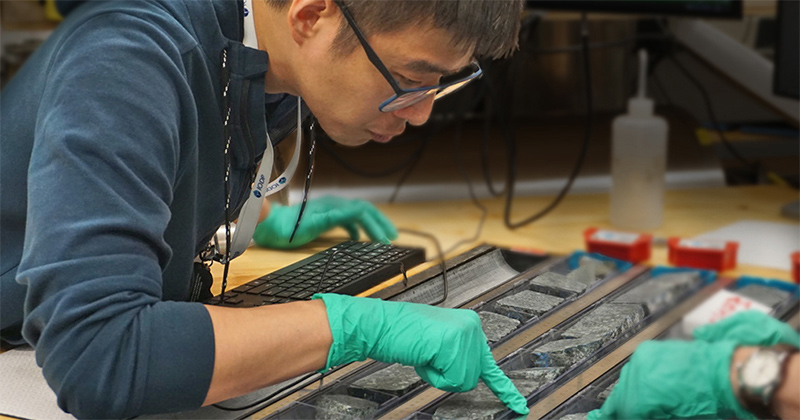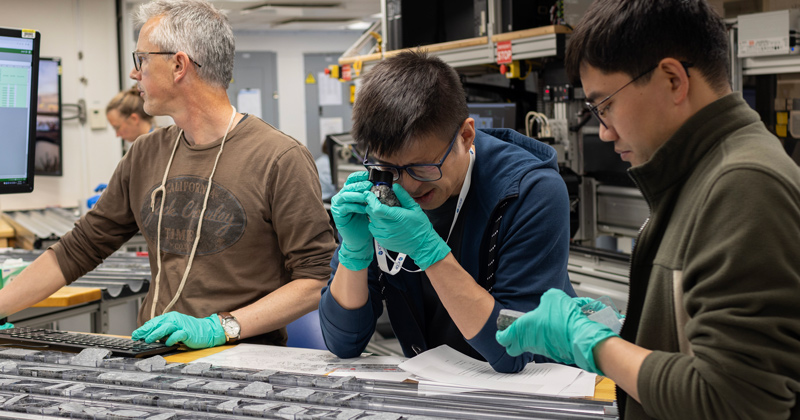


The origins of life
Photos courtesy of Leslie Anderson, Mark Reagan and Sarah Treadwell September 07, 2023
UD doctoral candidate Kuan-Yu Lin helps collect core samples from the Earth’s mantle
To find a modern analog that may help explain the origins of life on Earth, scientists are searching under the sea, specifically, where rocks from the Earth’s mantle are exposed in direct contact with seawater.
Kuan-Yu Lin, a doctoral candidate in the Department of Earth Sciences at the University of Delaware, was a recent participant on the International Ocean Discovery Program Expedition 399: Building Blocks of Life that sailed to the Atlantis Massif — an underwater mountain in the North Atlantic Ocean — to drill into and sample the Earth’s mantle. The research was conducted on the JOIDES Resolution research vessel.
Lin explained that the Atlantis Massif offers researchers a rare opportunity to take samples from the Earth’s mantle, as the Earth has close to a 4.3-mile-thick crust on the seafloor — which means that in order to collect samples from the mantle beneath the crust, researchers have to drill through at least 4.3 miles of rocks.
“The place we were drilling, however, is a tectonic window where mantle rocks were pulled up close to the seafloor by tectonic processes so we didn’t have to go through that deep, thick crust to begin with,” said Lin. “We were able to actually drill straight into the mantle.”
Scientific ocean drilling is filled with uncertainty — drills can get stuck, existing holes can collapse and the amount of rock actually recovered can be low.
“The original plan was to drill a shallow hole around 200 meters,” said Lin. “But to our surprise, the hole just kept going deeper and deeper with extremely high recovery rates that were never seen before when drilling these types of rocks. Stunned by what we were seeing, the science party agreed to change the plan to keep deepening the hole.”
The research team ended up drilling a record-breaking hole of 1,268 meters into the Earth’s mantle. They also had a 71% recovery rate, recovering 886 meters of rock samples from the Atlantis Massif. These are the longest seafloor core samples ever recovered for peridotites — a type of igneous rock typical of the Earth’s mantle. For reference, the previous record was 200 meters in length with 50% recovery rate.

The success of this hole quickly sparked excitement across the global scientific community.
“The previous record for the deepest hole drilled into this type of rock was set 40 years ago, in the early 1990s so recovering this amount of rock in two months at sea is astounding,” said Jessica Warren, professor in the Department of Earth Sciences. “I was getting periodic updates from Kuan-Yu when he was on the ship. It was fairly routine news at first, but then it became clear that he was involved in a record-breaking expedition — plus an extraordinary amount of work given how much rock the team needed to describe. But this opens up years of research into the physics, chemistry, and biology of the ocean floor.”
Lin agreed, saying these samples will serve many purposes and help different fields of research.
Life on earth
With regards to researching the origin of Life on Earth, Lin said that once these rocks are exposed to seawater, a reaction called serpentinization happens and produces molecules such as methane, hydrogen gas, and other simple organic molecules without the aid of biological catalysis.
At the Atlantis Massif, these reactions contribute to the development of a unique hydrothermal venting system, known as the Lost City Hydrothermal Field. Here, those molecules are used by microbes to build a sustainable environment, or life in the seafloor. By examining the samples, scientists can see how the rocks are reacting with seawater and how the microbes are distributed.
“That’s pretty significant because most life as we know it on Earth is mostly related to sunlight. So this is one of the lifeforms that is independent of sunlight,” said Lin. “Scientists think that this could be analogous to the early forms of life. Billions of years ago, when the Earth was hot, there might have been some rocks on the seafloor that were going through this reaction. There is consensus that life on Earth probably emerged from an environment rich in simple organic molecules, and thus scientists have been suspecting that places like the Lost City may be fueling the earliest forms of life.”
Another way the samples will be used is to look at plate tectonics, which is Lin’s primary research focus. Lin said that by drilling so deep into the mantle, researchers will be able to get additional insights into how plate tectonics works. Most of the time, studies of the seafloor and the mid-ocean ridges rely on a limited number of samples collected by dredging, or scraping off whatever rocks are exposed on the seafloor with a metal basket.

“This time, we were able to get a nice, long and continuous core that has really good spatial context so we know how different rocks are in contact with each other,” said Lin. “By having that spatial constraint, we can better understand how the ocean basins form and how they evolve as they go all the way to the subduction zones.”
Rock descriptions
For his role on the cruise, Lin worked as an igneous petrologist who described the core samples as soon as they came aboard the ship. The igneous petrology team on this expedition included Lin and three other researchers from different countries.
“It was an amazing, extremely collaborative environment where you get to interact with an international group of leading scientists in their fields on an everyday basis,” said Lin.
When the rocks were recovered from the seafloor, the first thing that Lin and the rock description teams would do is create the scientific descriptions of the primary features of those rocks — defining what kind of rocks they were, what minerals they had, and the physical descriptions such as fabrics and texture.
After a few years, the collected samples will be made publicly available to all scientists around the world who can request certain samples. These requests will be aided in large part by Lin and the team’s descriptions.
In addition, when cores get pulled up, they also get split in half. Half of the samples are archived and half are the working samples.

“The half that will be worked on later is the working half,” said Lin. “What we do is, when the cores come to the description table, we petrologists grab our hand lenses and describe what we see in the archive half. Then we think about the science that we want to do and make strategic plans to sample the working half.”
Lin also took thin sections of the rock samples, cutting the core samples down to 30 microns thickness so that the sections, which are now so thin that they are optically transparent, can be put on glass slides and examined under a microscope.
Future work
Now that he is back in Delaware, Lin said he is going to look at the composition of olivine, the most common mineral in the Earth’s upper mantle. Using the facilities at UD, he will target different samples from the Atlantis Massif to see how magma is formed and how these mantle rocks are emplaced on the seafloor. In addition, he will try to figure out the ages of the rocks to understand when magmatic events happened and when the rocks started interacting with seawater. This will involve collaborating with colleagues at other institutions.
He is also expounding the virtues and benefits of having research vessels like the JOIDES Resolution being able to explore the seafloor and beyond.
“This ship has been drilling cores from the seafloor for around 30 years, throughout multiple generations, creating a unique collection of samples that fueled decades of research,” said Lin. “Ocean drilling has been providing substantial insights into our understanding of the planet, not only the ‘hard rocks’ and how plate tectonics works but also our climate system, life, natural hazards, and a lot of other areas. The United States is a global leader in deep-sea drilling and we don’t want to lose that. It’s important to continue pushing for the next generation of deep-sea drilling so that we can keep advancing our understanding of the planet.”
To read more about the expedition, check out some of the additional coverage in the Washington Post and Science Magazine.
Contact Us
Have a UDaily story idea?
Contact us at ocm@udel.edu
Members of the press
Contact us at 302-831-NEWS or visit the Media Relations website

